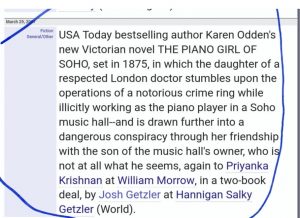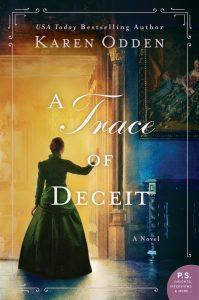Things I Wish I’d Known About Book Marketing
 Things I wish I’d known about book marketing: A few specific tips for the author who wants to sell books as well as write them!
Things I wish I’d known about book marketing: A few specific tips for the author who wants to sell books as well as write them!
(1) When people ask me how I found my agent, I tell them about Publishers Marketplace https://www.publishersmarketplace.com/. This is an enormous database that lists (nearly) every book deal, as well as the deals for movie/TV adaptations from books. It covers all genres, from cookbooks to YA to picture books to romance to historical fiction to biographies.
Each entry (I’ve included mine as a sample) provides the author, the agent, the publisher, and a brief synopsis. The database is also searchable. So when I was looking for an agent, I typed in: “Historical Mystery Agent.” This produced a list of dozens who describe themselves as interested in “historical” and/or “mystery,” including the seven agents who requested my manuscript and the two agents who offered me representation.
You can also find their websites, where they will explain how to query them. (Perhaps it goes without saying, but follow their instructions. Most want submissions by email, and if they ask for “one chapter pasted in the body of an email,” do not send them two chapters in an attachment. You are not twice as likely to have them open it. Attachments can contain viruses.)
 The subscription to PM costs $25 for the month, and in addition to this database, PM provides news articles with invaluable information about the industry. You can join for just a month, but I ended up subscribing for several months afterward as well, just for the industry scoop.
The subscription to PM costs $25 for the month, and in addition to this database, PM provides news articles with invaluable information about the industry. You can join for just a month, but I ended up subscribing for several months afterward as well, just for the industry scoop.
(2) As many book marketing people will say, grass-roots marketing and your “brand” begins with your website. I was absurdly naïve about marketing my books.
Years ago, the publishing houses took care of all aspects—book development, printing, and marketing, but that has changed a great deal, and now many authors find themselves doing most of their own marketing. (Trying to balance marketing the books with writing them is a subject for another article.)
However, I will say that it wasn’t until my third book was published that I began to understand the many opportunities to do grass-roots marketing online. I am utterly inexperienced in website design, so I worked with a freelance website designer, who used the website design program weebly , which is easy for a novice to navigate, once the framework is in place.
Weebly also hooks to mailchimp for easy administration of your mailing list. Whether you are an aspiring writer or a published one, I would suggest getting your website up and running at least 3 months before your book publishes, if not more.
If you have not yet created a website, take some time and review a variety of websites for other authors in your genre. Develop a checklist of things you’d like to incorporate into yours. A starter list probably should include: links to your social media (facebook, twitter, Instagram, etc.), “Buy Now” buttons, your bio with a headshot, cover shots and a synopsis and maybe first chapter of your book, your blog, and a place to list upcoming appearances, podcasts, and blogtours.
(3) Book review platforms. When you have a book published, reviewers will be able to post on Goodreads before your book’s pub date (for those reviewers who have been provided ARCs, or Advance Reader Copies). This is different from Amazon, which only accepts reviews after the book is published.
While some authors advise, “Never look at your Goodreads reviews,” my experience with Goodreads has been positive overall, in that I’ve found people who gave 4- and 5-star reviews to my first book, A Lady in the Smoke; after my third novel was published, I messaged those people via goodreads (there is a “message” option), asking if they’d like to read another, and most said yes. It’s a vibrant, engaged community with avid book readers including “Goodreads librarians.” Before your book is published, get on Goodreads and set up your author page; also go to Amazon and set up your Amazon Author Page (here is mine: https://www.amazon.com/Karen-Odden/e/B0186FIQF6/ref=dp_byline_cont_pop_book_1) which is where people can find out more information about you, including your bio, your website, and your blogposts. Other book review sites I like are Library Thing and Bookbub.
I have found it is best to use these as both an author and a reader. That is, when you read someone else’s book, write a review (if it’s positive). That review of their book becomes content for you. Post it on any platform you use, including these four sites and Instagram or Facebook or Twitter. It helps out your fellow author and gets your name out there, too.
When I first started writing reviews, I scribbled them in a notebook. It took me a while to get going with an online review habit, and at first, I only published reviews on Goodreads. However, now when I write a review for a book I like, I publish it (with an easy copy & paste) on these six sites: Goodreads, Library Thing, Bookbub, my Facebook page (personal and author), my book blog LoveBooksAZ and my website, under the “BOOKS I RECOMMEND” tab.
I also take a picture of the book and post it on Instagram, with a brief review and the line, “For the complete review, go to www.karenodden.com” and include hashtags. (Hashtagging is an art in itself, but eventually, you’ll find the ones you use most often to attract interest from people who follow different hashtags.
For example, I would tag A Trace of Deceit with #histfic #historical #Victorian #art #bookstagram #authorsofinstagram #mystery #suspense.) From Facebook, I post it on my personal page and my author page and then “share” the post to various pages for groups to which I belong, including (for example) Bookworms of the World, Historical Novel Society, and Women Writers, Women’s Books.
(4) I am not a visual person. But I have started using the author-friendly design tool CANVA . The basic level is free, and although you can obtain more designs, fonts, and design assistance from the version you have to pay for, even the basic one comes with some fun pre-made layouts, lots of background colors, and many serif, sans serif, and calligraphy typefaces. Use this to market your book with images that are professional and eye-catching. You can select which size and format you’d like (e.g. “Instagram Post” “Twitter” “Facebook” or a custom size). I’ve included some samples below.


For more tips about book marketing, please visit my website www.karenodden.com.
—
Karen Odden is the author of three mysteries set in 1870s London, with one more in the works. She earned her PhD in English literature at NYU and her critical essays have appeared in numerous books and anthologies. Her first mystery, A Lady in the Smoke, was a USA Today bestseller, and A Dangerous Duet and A Trace of Deceit both won awards at the NM-AZ book awards. She lives in Arizona with her family and her beagle-muse Rosy.
IG: @karen_m_odden
A TRACE OF DECEIT
 From the author of A Dangerous Duet comes the next book in her Victorian mystery series, this time following a daring female painter and the Scotland Yard detective who is investigating her brother’s suspicious death.
From the author of A Dangerous Duet comes the next book in her Victorian mystery series, this time following a daring female painter and the Scotland Yard detective who is investigating her brother’s suspicious death.
A young painter digs beneath the veneer of Victorian London’s art world to learn the truth behind her brother’s murder…
Edwin is dead. That’s what Inspector Matthew Hallam of Scotland Yard tells Annabel Rowe when she discovers him searching her brother’s flat for clues. While the news is shocking, Annabel can’t say it’s wholly unexpected, given Edwin’s past as a dissolute risk-taker and art forger, although he swore he’d reformed. After years spent blaming his reckless behavior for their parents’ deaths, Annabel is now faced with the question of who murdered him—because Edwin’s death was both violent and deliberate. A valuable French painting he’d been restoring for an auction house is missing from his studio: find the painting, find the murderer. But the owner of the artwork claims it was destroyed in a warehouse fire years ago.
As a painter at the prestigious Slade School of Art and as Edwin’s closest relative, Annabel makes the case that she is crucial to Matthew’s investigation. But in their search for the painting, Matthew and Annabel trace a path of deceit and viciousness that reaches far beyond the elegant rooms of the auction house, into an underworld of politics, corruption, and secrets someone will kill to keep.
Buy the book here
Category: How To and Tips, On Book Marketing
























Thank you – very interesting post.
Interesting ideas that writers can follow for their books.
Great advice! And I agree about Canva; it has been an indispensable tool for helping me promote my book.
You really took to marketing like a pro! I was especially taken with how you share your reviews in so many places. Thank you for these valuable tips.
Great post! I will use it — I love writing books, but I feel a bit deer-in-headlights about the prospect of marketing them.
I’m glad you found it useful! Cheers, Karen
Thanks for a useful article. I’ve been wondering what possible use I can make of Instagram.
Glad you found it helpful! 🙂
Yes, I was slow to instagram … but I’ve discovered an avid community of book lovers and bloggers. I’ve discovered some great friends and books I might not have found on my own. I hope you enjoy it! My handle is @karen_m_odden if you want to find me there. I post mostly about books … and hiking in AZ and my ridiculous beagle.
Thanks. I’ll look for you as soon as I dip my toe in the Insta-waters.